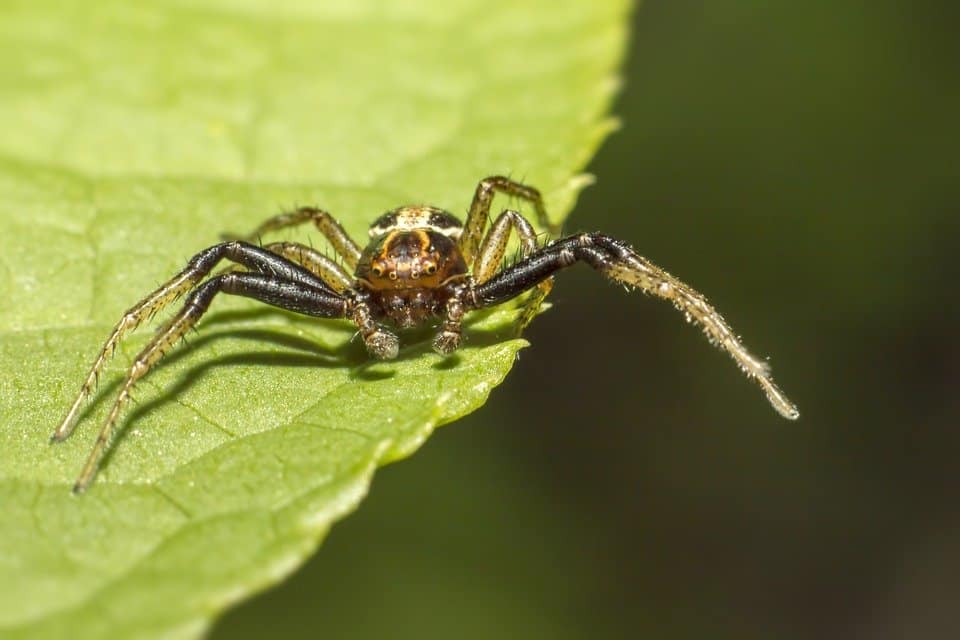
This banana spider size comparison is not for the faint of heart. After all, while spiders are cool critters that are an important part of the ecosystem, when you’re dealing with spiders as large as the banana spider, you may find yourself a bit squeamish.
The common name “banana spider” refers to the genus Cupiennius. There are 11 distinct species that are a part of this genus, and we’ll be talking about them all. The banana spider size is quite shocking.
How Big is a Banana Spider?

Banana spiders
can have legs up to 3.9 inches long!
Overall, banana spiders are medium-sized spiders found in Central and South America. They get their name from their habitat, which is usually around the banana trees commonly found in the warm, humid region. As a result, larger species of banana spiders can sometimes be found all throughout the world when they are accidentally transported with shipments of bananas.
Imagine going to the grocery store and seeing one of these spiders on your produce!
Size-wise, banana spiders’ bodies can range anywhere from 0.35 inches (9 mm) to 1.6 inches (40 mm). However, their legs are much longer – some nearly 3.9 inches (100mm) long! They have fuzzy brown bodies, although some species may have brightly colored areas on their body, especially their mouths.
Speaking of mouths, banana spiders are venomous. While they’re most commonly known as banana spiders, their other common names include hunting spiders due to their tendency to hunt down their prey rather than spin webs. This venom, which is equal to a bee sting for humans, allows them to easily catch and eat their prey.
The 11 species of banana spider include Cupiennius…
- bimaculatus
- chiapanensis
- coccineu
- cubae
- foliatus
- getazi
- granadensis
- remedius
- salei
- valentinei
- vodou.
Cupiennius getazi
Due to their popularity as a specialty pet, Cupiennius getazi is one of the most well-known species of the genus. They’re also one of the larger species, with females growing up to 1.5 inches (38 mm). Their legs can also be as long as 3.9 inches, giving this species of banana spider the ability to be several inches long from their back paw to their front paw.
Due to the banana spider size and coloration, Cupiennius they are often mistaken for Phoneutria spiders. These are highly dangerous spiders, especially compared to the banana spider. Where the bite of a banana spider may cause short-term discomfort, the bite of a Phoneutria spider can become a medical emergency quickly.
Human Hand Versus Banana Spider Size Comparison

From a baby to an adult, the human hand can come in many different sizes. However, unless you were to look at a young baby, it’s usually larger than most spiders – the banana spider included.
For a 6-year-old female, her hand can be as small as 4.4 inches from the tip of her fingertip to the area where her palm meets her wrist. Her index finger makes up around half of that total length. As a result, while a banana spider isn’t bigger than a 6-year-old’s hand, just its legs alone can be larger than her finger. There are only a few centimeters difference keeping the largest banana spider from being the same size as her hand.
Some larger species, when including their legs, can be longer than 5 inches. In this case, they’re often larger than even the largest average child’s hand.
The smallest banana spider has a body even smaller than most fingernails though! The average human fingernail is around 12mm, nearly a third larger than the body of the smallest banana spider species.
The average male adult has a hand length of 7.6 inches. This makes it almost double the body size of the largest banana spider, and 21 times as large as the body of the smallest. That’s the same as a human standing beside half of a giant Sequoia tree!
Tarantula Versus Banana Spider Size Comparison

Tarantulas are some of the largest spiders in the world
©Pixel Memoirs/Shutterstock.com
There are over 1000 species of tarantula, each one coming in a unique shape and size that creates a diverse collection of critters.
The Trinidad dwarf tarantula is one of the smallest tarantula species. They’re common as pets, but they can also be found in the wilderness of Central and South America, just like the banana spider.
At their largest, the Trinidad dwarf tarantula won’t get much larger than around 2”. Males of the species are only half that size, creating a noticeable difference between the two. This means that, at its maximum size, the smallest tarantula is still larger than the largest banana spider – at least when it comes to body size.
When considering the legs as well, the banana spider may be larger than tarantulas due to the fact their legs are nearly twice the length, if not larger!
The largest tarantula species in the world is the Goliath bird-eating tarantula. If one of these spiders were to be in your house, you definitely wouldn’t miss it. Their bodies can grow to be nearly 5 inches, and their legs can more than double that length. This means that just their legs are nearly 3 times the length of the banana spider.
The Goliath bird-eating tarantula is also large enough to be measured. They tend to weigh around 6.2 ounces, which is the same as a 2011 Amazon Kindle, three tennis balls, or two onions. This may not seem like much until you remember that you’re talking about a spider!
Thank you for reading! Have some feedback for us? Contact the AZ Animals editorial team.








